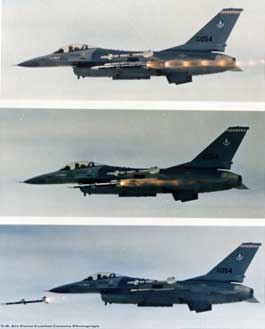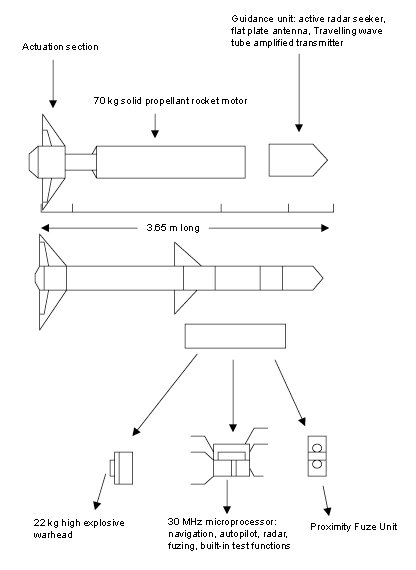
Programs affected by Hughes
The hybrid microcircuits manufactured by Hughes aircraft co. were used in a large variety of programs affecting every branch of the military and other cutting-edge technological government programs. The legal documents from the cases filed against Hughes list 73 programs for which Hughes manufactured hybrid microcircuits between 1985 and 1987 (see the list below). They do not state that every program was affected by the fraud, but simply that these were the program that used hybrids chips, and that hybrid chips were fraudulently passed off as having been appropriately tested.
If they are marked with an asterisk (*), they are one of the 27 programs that were definitely affected by Hughes during the relevant period of time. The other programs could have been affected, but no clear evidence was obtained to prove this. The lack of evidence may mean they were not effected, but it may also mean documents were falsified to show that some programs were not effected.
Not all parts of this chart can be filled in at this time for various reasons. We have filled in those we can, and provide links to places where you can get information about the various programs that is available on the web.
Hughes Acronym |
Item |
Client |
|
Fighter jet (Tomcat) |
||
|
|
Tank |
|
|
|
Missile Defense |
|
|
|
||
|
|
Grumman Intruder |
|
|
|
Firefire weapon locating system |
Army (Raytheon) |
|
|
Range and Approach Guidance |
|
|
|
Phoenix Missile |
|
|
|
Energy Supplier |
|
|
|
||
|
|
Loral S3A |
|
|
|
||
|
|
Amphibious Assault Ship |
|
|
|
Aviation Supply Office F-14 |
|
|
|
Advanced Medium Range Air-to-Air Missile |
|
|
|
Submarine Antenna Distribution System (SADS) or SADS (Simulated Air Defense System) |
|
|
|
Torpedoes |
|
|
|
Loral F-4 |
Loral Space and Communications |
|
|
Position Locating Reporting System |
|
|
|
Firefinder Radar |
|
|
|
||
|
|
Fighter jet |
|
|
|
||
|
|
||
|
|
Modular Universal Laser Equipment (MULE) |
|
|
|
||
|
|
Ground Laser Locator Design |
|
|
|
||
|
|
Hughes Air Defense Radar |
|
|
|
Fighter jet |
|
|
|
Fighter jet Multi-stage improvement program |
|
|
|
Military semiconductors |
|
|
|
||
|
|
Laser augmented Airborne TOW (Tube-launched, optically tracked, Wire-guided |
|
|
|
Power supplies |
|
|
|
Air Support Operations |
|
|
|
Gun System |
Division Air Defense |
|
|
||
|
|
||
|
|
||
|
|
||
|
|
||
|
|
||
|
|
Designed and built computers for military and aerospace |
Sperry Rand's |
|
|
Joint Tactical Information Distribution System |
|
|
|
||
|
|
International TeleCommunications Satellite |
|
|
|
||
|
|
||
|
|
Geosynchrous Orbital Environmental Satellite |
|
|
|
Unmanned Military Aerospace Vehicles |
Nord |
|
|
Advanced Synthetic Aperture Radar System |
|
|
|
Improved point defense/target acquisition system |
|
|
|
Antenna used on the space shuttle |
|
|
|
||
|
|
Bomber jet |
|
|
|
Gun Management System |
|
|
|
Laser Target Designator |
|
|
|
Thor Missile |
|
|
|
||
|
|
Merged with Hughes Aircraft |
Raytheon |
|
|
||
|
|
Hughes Delco Operations |
|
|
|
||
|
|
||
|
|
Semiconductors |
|
|
|
||
|
|
||
|
|
||
|
|
||
|
|
||
|
|
||
|
|
B52 Command Post |
A quick glance over the names of the programs and companies or branches of the military effected gives you an idea of how important these hybrid microcircuits are. Missiles, fighter jets, a bomber, radar systems, and an assault ship are extremely lethal and important systems. If something malfunctioned because of a faulty hybrid, the consequences could be dire indeed.
To give a more specific example of this, the AMRAAM (#15) will be described in terms of its history, capabilities, relation to the hybrid microcircuit, and the potential effect a faulty chip might have on it.
The AMRAAM and potential effects of chip failure
The Advanced Medium Range Air-to-Air Missile (AMRAAM) development program started in 1975. [28]. In February 1979, the AMRAAM program completed its conceptual phase. The United States Air Force (USAF) selected two companies as competing contractors to continue to develop the AMRAAM – Hughes Aircraft Co. and Raytheon Co. (Raytheon). Thirty-three months later in December 1981, both companies successfully demonstrated the effectiveness of their prototypes.
The AMRAAM was designed to outpace its predecessor the AIM-7 Sparrow by having higher speed, greater range, increased maneuverability, better resistance to electronic counter measures, an active terminal radar seeker, and improved reliability and maintainability. [28]. American was selected as the full-scale developer. Test missiles were launched sometime after full-scale development was complete, and kills in Operation Southern Watch and Bosnia proved the AMRAAM's capability. [29]. The AMRAAM entered service in 1991 after it was delayed by development problems.
The AMRAAM is a lethal missile that can be launched from the USAF's F-15 (Figure 1), the Navy's F-14, Germany's F-4, Britain's Sea Harrier and other aircraft from over seas Allied forces.

3.65 meters in length and weighing 157 kg before launch, the AMRAAM carries a 22-kg high explosive hollow charge blast effect warhead. The blast effect warhead does not explode upon impact with its target, instead when the missile senses it is within lethal range, it self-detonates. Even more, it is a directed fragmentation warhead filled with 198 separate rod-shaped projectiles. "It is reported that the proximity…system can sense which side of the missile the target is on and direct the blast/projectiles towards the target rather than being distributed in an even, circular pattern. [28]. The AMRAAM can travel at super-sonic speeds, and it can fly, in some cases, up to 40 miles to its target. [29]
Most importantly though, the AMRAAM has a built in radar system so the pilot of the F-15 or F-14 does not need to be an active participant in its guidance. Instead, they can concentrate on more important maneuvers like evading enemy fire. After leaving the range of the plane's guiding radar, and once it is within range of the enemy plane it goes into autonomous mode. This self-guidance system works using a technique called Semi-Active Radar Homing (SARH). Pulses of radar signal are sent out of the missile's head instead of a continuous stream of radar so the target cannot lock on to the missile's signal and administer counter measures. The missile's seeking system follows the target designated by a radar-lock from the warplane, and then it follows its own radar. This system virtually assures a kill when working properly.
The structure of the AMRAAM can be seen here:

Semi-Active Radar Homing and other functions of the missile's microprocessor did not evolve without the important microchip development of Hughes in the early 80's. Hughes was a pioneer in developing a hybrid microchip that was most likely used in the AMRAAM's 30 MHz microprocessor. American manufactured these microchips, which are actually contained in airtight, hermetically sealed containers, for all branches of the military in the 1980's. Hughes was supposed to test the containers according to the standards the Department of Defense required. Among other tests detailed in the standards, the box was to be tested for correct operation following exposure to extremes in temperature, vibration, pressure, and electrical shock. It was important that these tests be run, because one error in a decimal place in analog-to-digital conversion meant possible disaster.
The AMRAAM's missile head contains hybrid microchips. Using self-guided, Semi-Active Radar Homing, the AMRAAM receives analog radar signals that have bounced off the enemy plane. The microcomputer uses a digital code translation of the analog radar signal to plot the trajectory of the enemy plane. The microcomputer then sends the digital signal to a digital-to-analog converter chip. The information sent by the microcomputer tells the missile where it needs to be in order to intercept and destroy the plane. The new analog signal is then involved in moving the AMRAAM's rudders to correct it's own trajectory to intercept that of the enemy plane. This process occurs every few milliseconds and millions of times over the course of the missile's flight.
In light of the Hughes fraud, it is important to ask what could happen if the hybrid chips were not functioning correctly and the United States went to war. A pilot relying on an AMRAAM to destroy an enemy plane would be at a major disadvantage if his/her missiles were slightly off-calibration. In addition, there is the problem about where the missile goes if it does not hit the target. AMRAAM's have built in self-destruct capabilities if they are not locked on to a target. They have a maximum range of 50 km and a minimum range of 2 km. It would be rather important to feel safe firing a 22 kg high explosive warhead missile at an enemy plane 2km away from you. The speeds that these planes are travelling can make up that distance in seconds. Unforeseen explosions are a huge potential distraction for not only the plane that fired the missile, but other planes in the area.
These musings about potential failure of guidance systems can be replicated for each of the 27 programs we know were affected by the fraud, and perhaps for all 73 programs. The AMRAAM sounds more catastrophic because the guidance systems are working in vehicles travelling at very high speeds. But there are likely lethal consequences even for an Amphibious Assault Ship whose guidance systems go awry.
Although Hughes was convicted of fraud in not testing the chips, there is no way we can be sure the chips were actually faulty (or actually fine), short of finding all the chips in all the weapons systems listed above and checking each one. This is obviously prohibitively expensive, so we still do not know how many (if any) leaking or otherwise badly compromised.